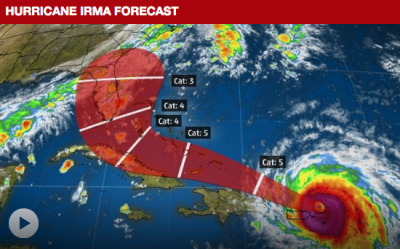Hurricane Irma: Preparing for the Worst
As Hurricane Irma sets its sights on Florida, Georgia and the Carolinas, The Fine Art Group has prepared a list of what to do before, during and after the storm to minimize the loss of tangible assets. Along the Gulf Coast in the wake of Hurricane Harvey, many residents are facing the consequences of inadequate insurance coverage and lack of planning for their tangibles. There has been a large increase in thefts, as well as flood and water-related damage to home contents including art, furniture, decorative arts and jewelry.

Image provided by Weather.com.
While protecting your tangible assets it is important to prioritize your safety, and the safety of family, friends, neighbors and pets. The National Hurricane Center and FEMA have provided additional guidelines and resources for hurricane preparedness.
Here is a list of suggested actions you should take now:
PREPARATION BEFORE THE STORM
- Discuss insurance coverage with your broker. Review your policy for costly gaps in coverage. If moving any fine art, verify that your collection is insured during transit. Some insurance companies have a waiting period before activation of policy changes, so plan ahead.
- Determine the type of damage your building and area is likely to suffer. Are trees likely to fall from strong winds? Have them trimmed regularly to remove weaker branches. Do you have lots of windows? Prepare to board them up. Are you located in a flood zone? Know where you can find sandbags in the event of an emergency and avoid storing valuables in the basement.
- Update your inventory with photographs and copies of your receipts. For maintaining records of your tangible assets, The Fine Art Group offers video inventories that can be shared with your insurance broker and used to reconstruct the contents of your home in the event of a loss. Think about items you have acquired recently or didn’t have included in a recent appraisal.
- Maintain a list of fine art shippers, art storage facilities, conservationists and your insurance broker. Turn your smartphone camera into a scanner with apps like CamScanner and Scannable to capture records and receipts digitally to store on the cloud and store important paper records in a waterproof safe.
- Establish a plan to relocate valuables. Select a reputable fine art shipper to move valuables to a predetermined secondary location out of the storms path.
- Collect all of the recommended items, below, for your Tangible Asset Emergency Kit.
- If you are likely to be away in the event of an emergency, communicate emergency plans with your property manager. Ensure they are aware of your valuables and know how to handle them during an emergency.
DURING STORM WARNINGS AND ACTIVE STORMS
- Board windows and establish a perimeter of sandbags around flood-prone zones.
- Remove art from damage-prone areas. This includes art facing windows and art hanging on walls made of plaster. Plaster becomes damp and may not have the structural integrity to support works of art.Learn from the mistakes of Hurricane Sandy and avoid storing valuables in the basement.
- Move works of art to a safe room, preferably a room without windows located at the center of the structure. Pack valuables in waterproof crates and plastic bins. Use acid free cardboard to prevent frames and works on paper from touching. You may also carefully wrap valuables in plastic poly to prevent water damage, possibly using acid free cardboard (and extra caution) to protect the surface. If possible, keep the works of art elevated from the floor should flooding occur.
- Monitor the storms progress and be prepared to evacuate.
HURRICANE EMERGENCY KIT FOR FINE ART PROTECTION
DEALING WITH THE AFTERMATH
- If the structure is secure, begin assessing the damage. Photograph overall damage to the site with subsequent photographs of specific damage.
- Do not throw away any damaged items! Even if the item is a total loss, consult with your insurance broker first and photograph the item for later claims.
- Move items out of harms way and to a safe, dry location.
- If necessary, put the dehumidifier and wet vac to use! Create an air-flow with fans and the AC. Clearing the air of moisture is key to preventing further damage from mold.
- Inspect the property for any new leaks and board up any damaged areas.
- Inform your insurance broker and begin the process of filing a claim. If faced with sizeable damage to your collectibles and art, establish a plan of action with your insurance broker in collaboration with art handlers, conservationists and appraisers.
MORE TIPS
Like an Emergency Kit, we recommend keeping these items on hand to manage your art collection in the event of a natural disaster. These items can be used to thoroughly document any damage, protect your collection as best as possible during an emergency, and prevent further damage from occurring.
- To document: Digital camera with extra memory card, batteries and charger, pencils, notepad, flashlights with additional batteries.
- To pack and transport: Latex gloves, rolls of plastic poly, packing tape, string tags, labels, scissors, box cutters, markers, acid free cardboard sheets and tissue paper.
- To protect during and after: Sand bags, plastic bins, waterproof crates, buckets, portable generator, dehumidifier, wet/dry vacuum, fans and extension cords.
OUR SERVICES
Understanding value is the cornerstone to effectively managing a collection – and at The Fine Art Group, it is this understanding that enables us to work as trusted fiduciaries for our clients, and their objects. We are experienced providing appraisals for a wide range of purposes, and are also specialists in unique and complicated appraisal scenarios.


